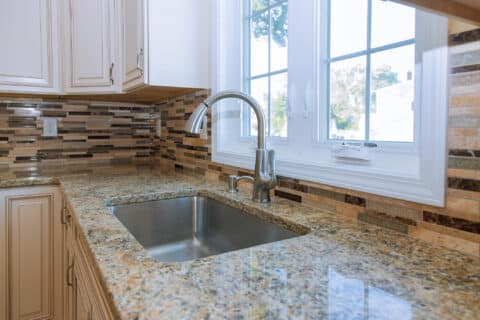Installation Considerations for Granite Countertops
Granite countertop installation is a meticulous process that requires a skilled approach. This process involves the selection, preparation and placement of granite slabs that have been fabricated to fit a particular application or space. Granite or stone installation must be done carefully and precisely to create visually appealing countertops in your kitchen, bathroom, or living space. There are many important steps and considerations when it comes to granite countertop installation.
Selecting the Right Granite
Granite is one of the most popular stone countertop materials. Some of the most common types of granite include:
- White Granite
- Colonial White Granite
- White Ice Granite
- Black Galaxy Granite
- Brown Granite
Choosing the right granite slab for your project can be overwhelming because of the many options you have to choose from. Granite is a natural stone that is quarried into slabs, so its mineral composition varies with each slab. In general, granite slabs are extremely hard and durable and can be used for any application. When selecting your granite slab, you should look for one that matches your design and complements your aesthetic.
Granite countertops offer a wide range of colors and patterns that will give you an array of options to choose from. Each slab is unique in its mineral make-up, creating variations in color, specks and veining. For this reason, it’s recommended that you pick out your granite slab by hand to ensure that it aligns with your overall vision.
Accurate Measurement
 When it comes to your granite installation, precise measurement is important. This will determine how the final product will turn out. When measuring for your stone countertops or application, you should start by creating a template with the exact measurements needed for your stone. This will act as a guide for cutting the granite slab to the correct dimensions and shape.
When it comes to your granite installation, precise measurement is important. This will determine how the final product will turn out. When measuring for your stone countertops or application, you should start by creating a template with the exact measurements needed for your stone. This will act as a guide for cutting the granite slab to the correct dimensions and shape.
Taking accurate measurements is a critical step in the installation process, which is why it’s strongly recommended to hire a professional to take these measurements. Depending on the look you are aiming to achieve, you may need to consider things such as your stone’s edge profile, overhang and seams when measuring. Marking and measuring for cut outs, such as sinks or outlets, is also critical during this phase. Make sure you have fixtures and appliances on-site while taking measurements.
This phase is arguably the most important because of the detail and accuracy involved. One small mistake when measuring can result in your granite slab being no longer useable for your project. An industry professional such as a granite templator or fabricator is the best person to recruit for your granite installation measurements.
Preparing Your Space
Prior to your granite countertop installation, there are certain preparations you should consider such as:
- Remove existing countertops
- Create a clear walk-way and workspace
- Cover surrounding furniture that may be susceptible to dust and debris
- Inspect and prepare cabinets and support structures
To ensure the installation process goes as quickly and as smoothly as possible, you should have any pre-existing countertops removed. If you are hiring a professional for your granite countertop installation, they may offer removing and disposing of your countertops for you. You should inquire about this information before your installation time to ensure you are as prepared as possible and do not delay your project.
Stone is extremely heavy and can be difficult to handle. Creating a clear walkway and workspace will help prevent any damage to your home or someone from getting hurt. This process can also create dust and debris, so you should cover any fixtures or furniture that are directly in the workspace.
Another important factor to consider with granite installation is cabinet inspection and reinforcement. Granite is one of the heaviest stones and will need a strong support structure that can withstand the weight of the granite for years to come. You should carefully inspect your cabinets or support structure prior to your granite installation. If your structure does not have the proper support, your granite countertop can wear and damage your cabinetry, causing further structural issues such as sagging or uneven support. This can damage the stone by causing cracks, stress and seam separation. Taking preventive measures and addressing these potential structural issues will help prolong the lifespan of your granite countertops.
Sink and Faucet Integration
 Granite installation in kitchens, bathrooms, and spaces that involve sink and faucet integration will require special considerations from other projects. When selecting and sizing a sink for your granite installation, you should consider:
Granite installation in kitchens, bathrooms, and spaces that involve sink and faucet integration will require special considerations from other projects. When selecting and sizing a sink for your granite installation, you should consider:
- The type of sink
- Space and dimensions
- Faucet placement
- Functionality
- Style
The type of sink will impact the installation method and requirements for your sink design. Undermount and top-mount sinks will determine the installation process for proper integration. Undermount sinks are attached underneath your countertop and will have a less visible seam.
A top-mount sink, otherwise known as a drop-in, is self-rimming and sits in a pre-cut hole that is fabricated from your countertop. The rim sits on top which often results in a seam along the edges. It’s important to have the seams filled with a strong and waterproof adhesive during installation so that it does not deteriorate from water or moisture. These sink designs can also be fabricated and customized out of the same granite to match your countertops.
Faucet installation and hole placement must be considered if they are a part of your stone design. You should plan the placement of your faucet and accessories such as soap dispenser prior to fabrication and installation so that the proper measurements and cutouts are made. In order to successfully integrate your sink design, the sink will need to be available and on-site for final fitting on the day of installation — including any faucets, handles or accessories.
Hiring a Plumber
In some cases, a plumber is needed for your granite installation if a sink is involved. Plumbing services will include connecting the sink and faucet to the water supply lines and drainage system as well as ensuring leak-free connection. Most installers do not offer plumbing services so you should consider this when preparing for your countertop installation.
Seam Placement and Quality
Depending on the size and complexity of your project, seams may be necessary and are inevitable when connecting multiple pieces of granite. A seam is where two separate pieces of granite are joined together to create one solid surface.
Proper seam placement is important to enhance the aesthetic of your countertop. Installers often strategize the best position for seams to minimize their visibility. The exact placement can depend on the size, shape and feasibility of your stone design.
Some installers are more skilled at hiding seams than others because of special equipment and techniques that help reduce their visibility. Installers with special equipment and the ability to transport large slabs are often able to eliminate seams all together by fabricating your stone design out of a single slab of granite. Large or uniquely shaped designs, however, may result in more seam placements. Filling these seams with an adhesive that is a similar color to the granite, as well as matching veining and patterns between conjoining slabs, will help make seams appear discreet.
Making sure seams are strong and inconspicuous will elevate the aesthetic of your countertop or application. This will create a consistent and cohesive design. The quality of the seam is important for structural integrity and proper stability. Well-executed seams are set snugly, provide essential support and are visibly undetectable for a seamless look.
Maintenance and Warranty
 Once your granite countertops are installed, they will require some maintenance to maintain their beauty and longevity. Granite is relatively easy to maintain and should be sealed upon installation. A proper stone sealant acts as a protectant by filling pores found in natural stones to prevent staining or etching from occurring. Even with a sealant, you should clean your countertops daily and clean messes or spills as they occur. The amount of maintenance required for your granite countertops depends on use and should be considered with your granite installation.
Once your granite countertops are installed, they will require some maintenance to maintain their beauty and longevity. Granite is relatively easy to maintain and should be sealed upon installation. A proper stone sealant acts as a protectant by filling pores found in natural stones to prevent staining or etching from occurring. Even with a sealant, you should clean your countertops daily and clean messes or spills as they occur. The amount of maintenance required for your granite countertops depends on use and should be considered with your granite installation.
If you are hiring a professional installer for your granite countertop installation, you should consider whether they offer a warranty for their products and services. Stone is a natural material that can last for decades, but improper installation can result in failure or defects. Making sure your granite countertop installation is covered under warranty can save you money in the long run.
Granite and Marble Designs Provides the Best Granite Countertop Installation
Granite and Marble Designs follows industry standards and best practices for all granite countertop installations. Our skilled installers are experts at countertop installation and know the importance of taking precise measurements to execute the design of your project. Our StoneDoneRight™ Approach promises that the quality of our work is as solid as our product, and we aim to exceed customer expectations.
We offer a limited lifetime warranty to our customers for added value and transparency. If you are looking for the best stone countertop installation in Denver, Granite and Marble Designs is the place.
Get a free online quote or call to schedule a visit to our showroom to see our work in person.
